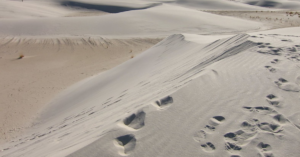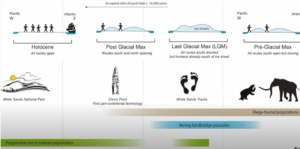Researchers Have Found Fossilized Footprints Of The Oldest Humans In North America
Researchers believe the footprints are 23,000 years old.
White Sands National Park in New Mexico was the site of a recent find. It has many researchers paying attention, because it is thought that the first humans in North America left footprints, and the fossilized footprints have now been spotted.
Resource manager David Bustos, who works for the park, was the first one to spot the fossilized tracks. Archaeologists and researchers are now coming from Bournemouth University, Cornell University, the University of Arizona, the National Park Service, and the US Geological Survey.

Although they aren’t sure of the age of the tracks, some feel as if they may be up to 23,000 years old.
According to NBC News, Matthew Bennett, a professor of environmental and geographic sciences at Bournemouth University, said it is the earliest “unequivocal evidence” for humans in the Americas.

He went on to say: “A footprint is a really good, unequivocal data point. That’s the importance of this site—we know they were there… There are multiple footprint layers spanning a significant amount of time, suggesting a sustained human presence in the area during the Last Glacial Maximum, as opposed to a single event.”
At the time that the footprints were thought to be left, the area was a wetland, but these days, it is primarily a desert. The humans would’ve been surrounded by prehistoric animals, such as giant ground sloths, wild camels, and mammoths.

Along with the human tracks, there are animal tracks in the area so it was likely a hunting ground. When the human left the footprints, it was likely a soft mud area on the banks of a shallow lake. That area is now part of the Alkali Flat at White Sands National Park.
Scientists used radiocarbon dating on seeds that were found in the footprints and the layers of sediment above and below. They did so to determine when the markings occurred.

Although radiocarbon dating is considered by many to be unreliable, Kathleen Springer of the US geological survey. According to Bournemouth University, she says: “Our dates on the seeds are tightly clustered and maintain stratigraphic order above and below multiple footprint horizons.” She went on to call the find a remarkable outcome.
SKM: below-content placeholderWhizzco for DOT

